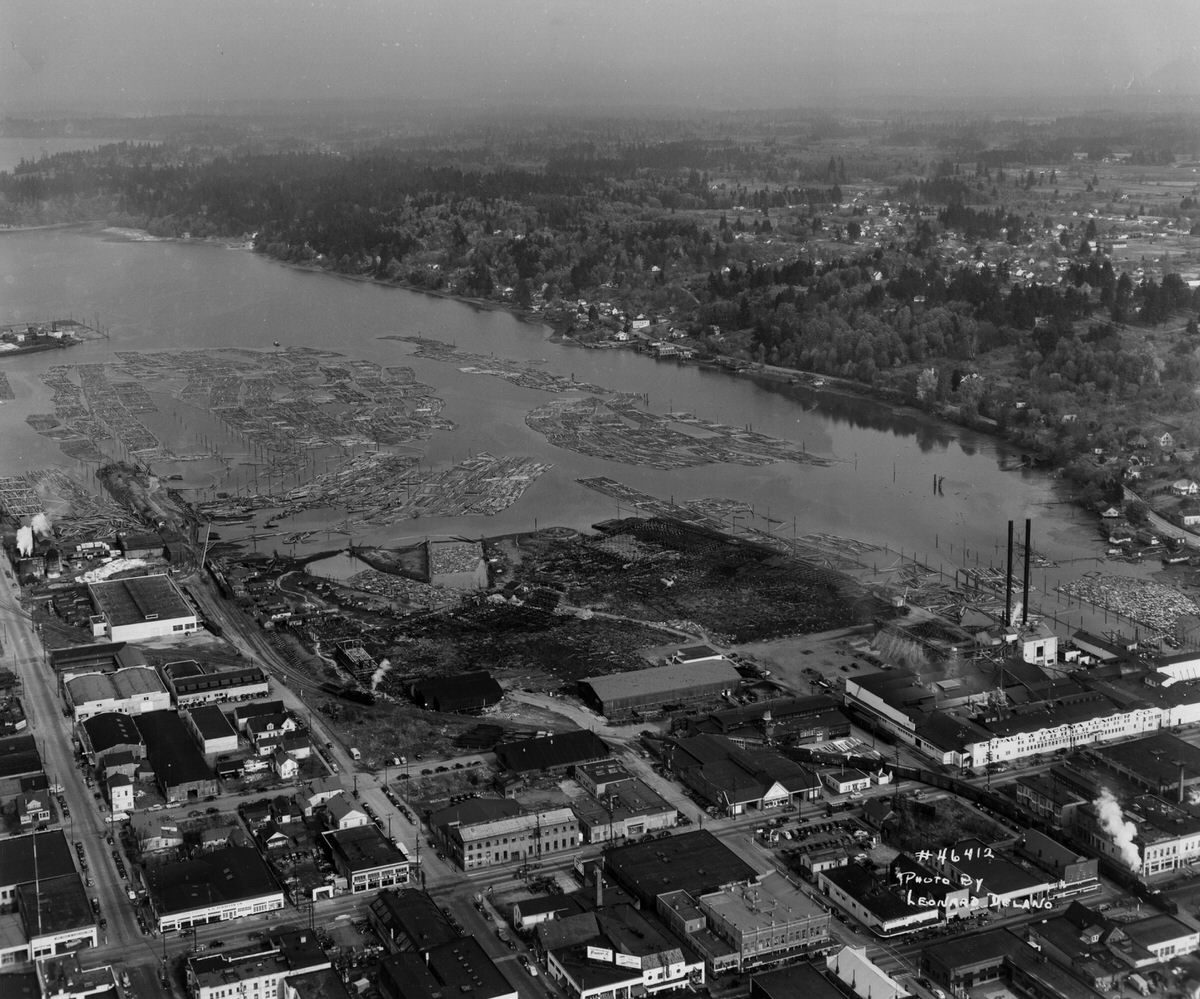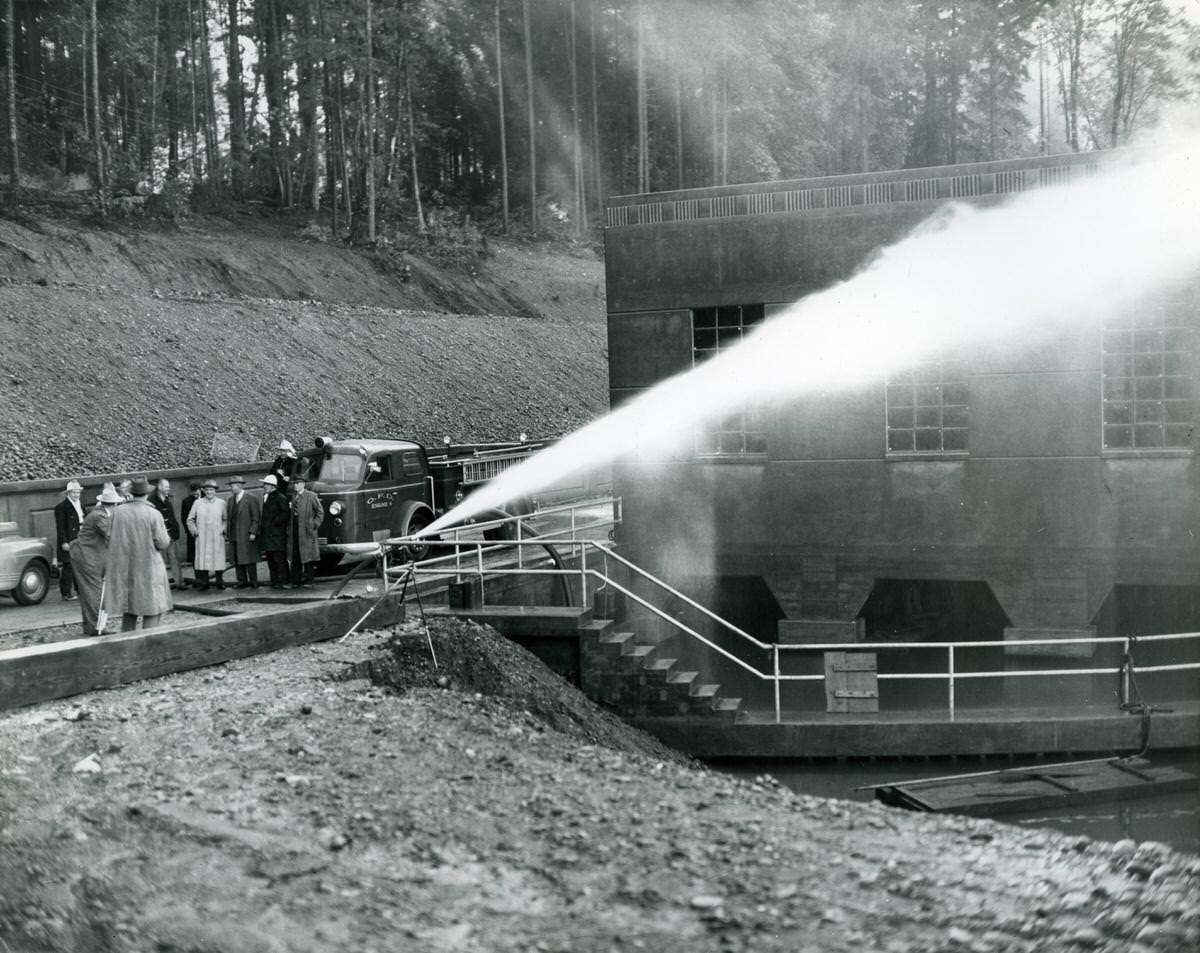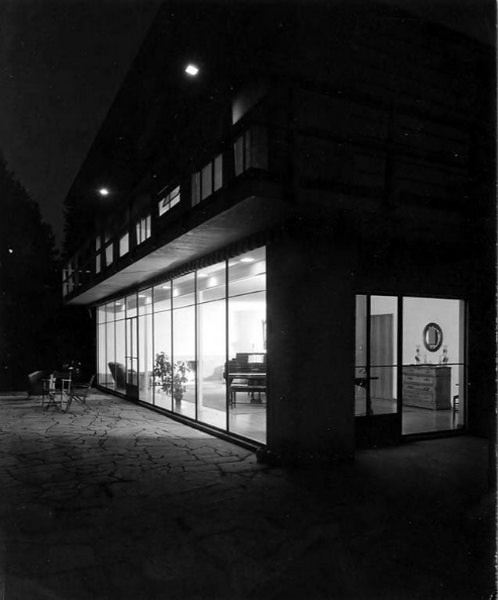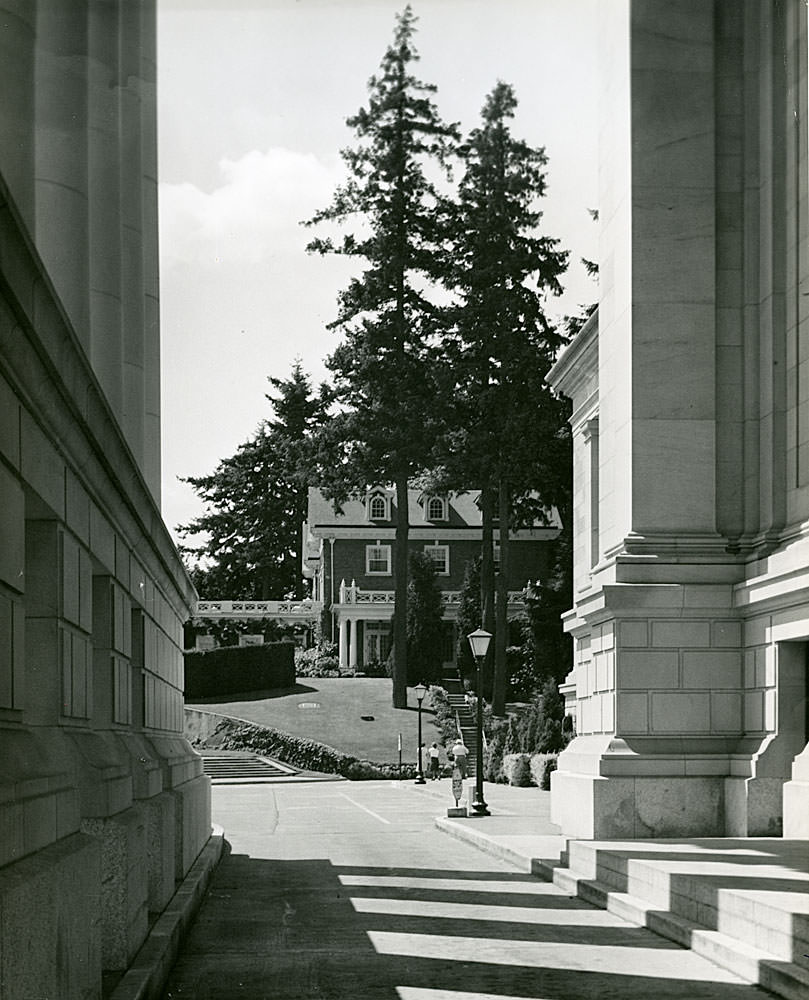Olympia experienced hard times during the Great Depression but also experienced drama. It was never precisely measured, but unemployment was as high as 23 percent. In Olympia’s shadow grew Little Hollywood, a shantytown of unemployed men and women inspired by Hooverville. The Unemployed Citizens League marched from Seattle to Olympia in January 1933. They demanded relief in the form of unemployment insurance, a ban on foreclosures, and free water, light, and gas from the governor and legislature. They encountered locked doors and State Troopers in the corridors. Another group of Seattle residents arrived in March 1933 to demand higher taxes on the rich and milk and hot lunches for the children. They were surrounded by 800 police officers and men claiming to be American Vigilantes of Thurston County in Priest Point Park. Some marchers met with the governor, but most dispersed.
World War II brought an end to the Depression era, and Olympia’s shipyards and airports were satellites of McChord Field. For the Soviet Union, the port provided a significant conduit for lend-lease materials. A mothballed fleet of up to 185 ships was moored at Gull Harbor north of the port for the next 30 years. In the 1940s, the port continued to thrive. Capitol Lake was created by damming the Deschutes River, entering Budd Inlet to reflect the Capitol dome.
On April 13, 1949, an earthquake severely damaged the capitol dome and several old buildings downtown.
Take a look into the 1940s Olympia through these stunning historic photos. Also, check Olympia in the 1900s, 1910s, and 1920s.
#1 Chief William Shelton’s story pole, 1940
#2 Hotel Governor located at 621 Capitol Way, 1940s
#3 Vagabond, Olympia, 1940s
#4 Capitol Lake and Deschutes Dam construction, 1949
#5 Downtown Spokane, 1940s
#6 East Bay and downtown Olympia, 1946
#7 Olympia Fire Department at McAllister Springs, 1947
#8 Olympia High School after removal of parapet and brick stack, 1940s
#9 Rear of Zamberlins market in Little Hollywood, 1941

Zamberlins market and Anchor Hotel in Little Hollywood. Little Hollywood, Olympia, WA's shantytown, was torn down to make way for Capitol Lake. The exact location of where this photograph was taken is unknown. Little Hollywood was located at the current location of the east shore of Capitol Lake.
#10 Washington Standard printing office, 1940
#11 Brodie residence, exterior view at night, Olympia, July 1944
#12 Brodie residence, exterior view, Olympia, July 1944
#13 Fire engine in front of damaged building with M. D. Pharmacy, Olympia, April 1949
#14 Steenson construction company truck parked in front of damaged Bettman’s Men’s Shop Inc, Olympia, April 1949
#15 Port of Olympia, 1946

We are looking at the industrial north end of the city. Railroad tracks run to the far northwestern point of the port. An oil tank is adjacent to the water with the Texaco logo on it. Rafts of logs are floating in the water. Lumber is stacked on the ground and there are warehouses at the northern end of the port.
#16 Rudkin House, 1005 Olympia Avenue, 1946

Only part of this house is visible, but it is at least two 1/2 stories tall, with varying rooflines, a wraparound porch with a second story sunroom over it, multiple angles. A short set of steps leads from street level to entry level. This is part of the Adah Dye collection of buildings over 50 years old.
#17 Olympia Hardware, Labor Temple, Kay’s Chop Suey, 1948

To the left of the image is a tavern, with its name not visible. To its right is the Olympia Hardware Store, a one-story building (109 Capitol Way). It has storefront windows on either side of the entry and two signs reading Olympia Hardware Co. The business to the right, located in the same building, is Kay's Chop Suey. This is one of the oldest commercial buildings in Olympia. To its right is the two-story Labor Temple (Woodruff Block), 119 N. Capitol Way. It is a two-story building with bay windows on second floor, the words Labor Temple painting on the side at roofline, decorative cornices at roofline, and a cafe at ground level. Banners stretch across the wide paved street. This is part of the Adah Dye collection of buildings over 50 years old.
#18 Fourth Avenue, Olympia, 1940s

The view is looking east and taken from above. Commercial buildings line the street in the foreground, giving way to trees and residences in the background. Businesses include the Franklin Hotel, C.R. Harris paint store, Christensen Radio Shop, the Avalon Theatre, Boone & Day Insurance, and Karl's Shoes. A billboard advertises Hamm's Beer. Beyond the theatre is a building that is undergoing construction, possibly as a result of the 1949 earthquake. The roof is covered with debris, and a man stands on the roof. The street is paved, and a set of trolley tracks runs along its center. Cars are parked on either side, and a few cars are proceeding eastwards (it is a one-way street).
#19 Olympia Country and Golf Club, clubhouse, 1940s
#20 Governor’s Mansion from the Legislative Building, 1949
#21 Forbes House, at 10th & Washington, Olympia, 1948
#22 Legislative Building reception room, Olympia, 1949

The room is lined with marble. In the center of the room is a round table with four chairs. We are looking toward the entrance to the room, with three doorways draped with velvet drapery and decorated with the Washington State Seal. Beyond the entries we can see the balcony overlooking the rotunda. A signboard is mounted on an easel by the left-hand entry.
#23 Legislative Building, Capitol Campus, Olympia, 1949

A tramway is in place that was used to bring workers and materials to the top of the building in order to replace the original stone lantern. A platform has been created around the base of the lantern. We see the old lantern in place before it was removed and replaced. At the right of the image is the Insurance Building.
#24 Clark’s Crane Cafe, 407 Capitol Way, Olympia, 1949

The cafe building is two stories, of stone or brick. At the second story are two sashed windows flanked by a tall arched window. A neon sign reading Clark's Crane Cafe hangs from the upper story, with the image of a crane. Below that is another sign reading Olympia Oysters. A fixed awning has lettering on it reading Clark's Crane Cafe. . At street level, there are two picture windows in either side of a central doorway. The words Clark's Cafe, with the crane logo, are printed on the windows. At the lower right of one of the windows is a Red Cross insignia. To the left of the cafe is a one-story building faced in black. Although this building has no sign on it, there are objects of art in a small display window, and inside there is a Red Cross symbol with a sign reading Give. A man is crossing the paved street in front of the building.
#25 A.A. Phillips House, Olympia, 1945
#26 Two story Mower House (now terms the Adams house, on the local register), 135 North Cushing, Olympia, 1948.

It has a full porch supported by slender columns, sashed windows at second story and small windows in the front gable. It is landscaped with shrubs and a small evergreen tree. This is part of the Adah Dye collection of photographs of buildings over 50 years old. The building still exists (2010)
#27 Legislative Building lantern under repair, Olympia, 1949

In the foreground are residential roofs and trees, with the Legislative Building dome visible behind the trees. A scaffolding has been erected around the lantern, with a platform around its base. Leading up to the scaffolding is a tramway that was used to bring workers and materials to the top of the building. We see the old lantern in place before it was removed and replaced.
#28 125 17th, M.E. George House, Olympia, 1949

It is an unadorned clapboard house with two sashed windows above the front covered porch, and a small window under the eaves. There is an entryway with sashed windows at ground level. A sidewalk runs alongide, and a paved street. Part of the Adah Dye collection of homes over 50 years old. This house is on the local register.
#29 Weatherbie House, Olympia, 1948
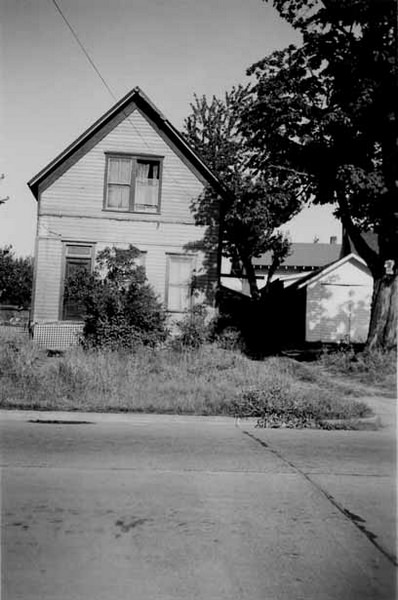
A sashed window is under the eaves, with tall sashed windows at ground level. Slender decorative corner pieces and bellyboard, and clapboard siding. There is lattice skirting. The lawn is unkempt and there are mature trees visible at the side, along with a small shed. This is part of the Adah Dye collection of buildings over 50 years old.
#30 A.A. Phillips House, Olympia, 1945
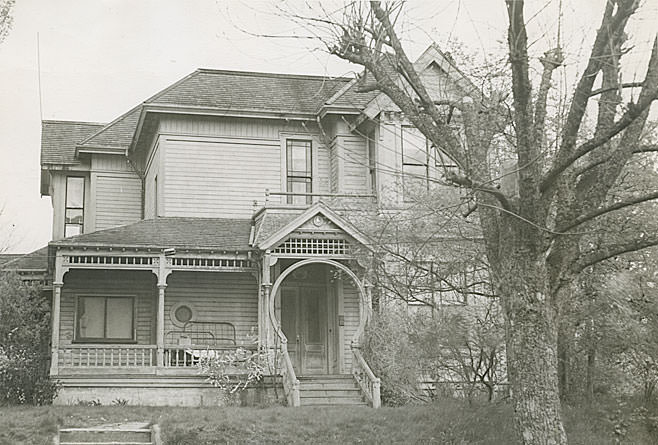
It is a two-story home with two-story bay windows on two visible sides, ornamental shingling, a small balcony on second story, and wrap-around porch. On the porch is a metal bedstead. A set of steps leads to the entrance. A tree is in the foreground. The lawn is unmown. This home was located at 11th Avenue between Capitol Way and Washington Street.
#31 Dr. Mowell House, 1941

The building has two wings separated by an entry way and a turret-like gable in the roofline. There are sashed windows on the second floor and large paned windows on the first floor. At roofline on each wing are three small vertical windows. The house is landscaped with immature trees. This is part of the Adah Dye collection of photographs of houses over 50 years old.
#32 Percival’s Dock, Water Street, Olympia, 1940
#33 Raudenbush Motor Company and Nommensen Furniture Company, 1940

The large three story building is the Raudenbush Motor Company, located on the southeast corner of 4th Avenue E and Cherry St SE, the present site of the Olympia City Hall building. The upper floors were apartments, and they were reportedly managed by the Nommensen family, but the lower level was George Raudenbush's establishment. Raudenbush was in business at this location from the 1920s or 1930s and it was previously a Hupmobile dealership. Raudenbush remained in business at this location as an auto parts dealer and repair shop into the 1980s.
#34 Bigelow House, Glass Avenue, Olympia, 1946
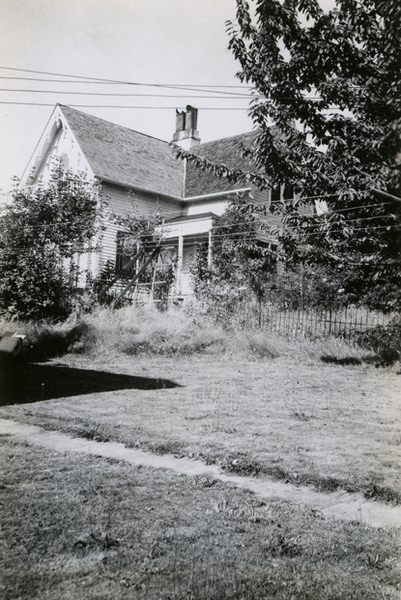
The frame house has a two-story ell, with ginger breading at eaves and a porch. A trellis is propped up against the porch. The house is mostly obscured in this picture by a tree and shrubs. An iron railing runs along the side of the house. It appears to be in some disrepair. In the foreground is a grassy, weedy stretch with a dirt track running along it. This is part of the Adah Dye collection of buildings over 50 years old in 1937. The house still exists as the Bigelow House Museum (2010), on the local and national heritage registers.
#35 Van Arsdale Hardware and Bill’s Cafe after 1949 earthquake

The building on the right is identified as Van Arsdale Hardware Store (also known as Willard Hotel and Bettman Building), 316 Fourth Avenue E. It is a brick building 3 stories high with brick parapets. It is in the process of partial demolition, with the front facade completely removed. A wooden protective walkway has been erected in front of the building. A firetruck is parked alongside the building. The building to the left, Bill's Cafe, 314 4th Avenue, is a one-story building. A sign reading Bill's Cafe hangs vertically from the upper level. The protective walkway runs in front of that building as well. Trolley tracks runs along the street. A small group of men is looking at the truck or building.
#36 Reed Building after 1949 earthquake
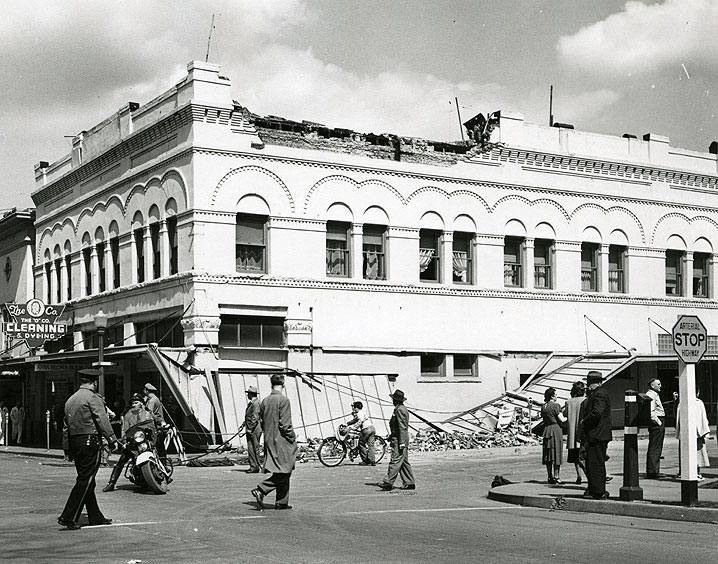
It is a three-story building with decorative features around and above the second story windows, and Corinthian columns at ground level. At the roofline a large piece of the decorative superstructure has crashed to the ground. It has taken with it part of a fixed awning, and debris is on the ground around the fallen awning. The side of the building facing Washington street is intact. A sign extending over a fixed awning reads The "O" Co Cleaning & Dyeing. A painted sign in the doorway reads Anna Blom Books. In the foreground are the paved streets of Legion Way and Washington. Pedestrians are standing on the corner and in the street. Two police officers are in the intersection, one on a motorcycle and one on foot.
#37 Demolition of Kneeland Hotel after 1949 earthquake.

In the foreground is the intersection of Capitol Way and Fourth Avenue. All four stories remain, but window frames have been removed. A crane is erected to the side of the building, with a bucket carrying away debris. Two workers are standing on the top level. Two traffic lights have been encased in protective wooden casings, with just the lights visible, presumably to protect against falling debris. Some debris is on the ground at the base of the building. In the foreground are a pickup truck and an automobile, and two pedestrians.
#38 Angelus Hotel building, Olympia, 1940s

It is a large three-story structure with its longer side along Fourth Avenue. Fixed awnings stretch along the longr side. A sign over an entryway reads Angelus Hotel, and a painted sign on the building reading Rooms and Apartments. On the ground floor are businesses, including Heye Brothers groceries. Automobiles are parked along the street, and one is proceeding westwards on Fourth Avenue.







